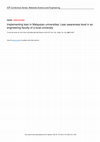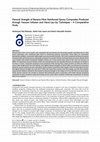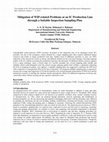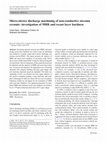Papers by Mohamed Abd Rahman

International Journal of Powertrains, 2021
Reuse of waste materials as reinforcement phase in metal matrix composites is considered as one o... more Reuse of waste materials as reinforcement phase in metal matrix composites is considered as one of the key areas of research due to many advantages such as cost reduction due to abundant availability of the waste materials, unchanged strength of the resulting composites and no special process required for producing composites. In Oman, it is reported that around 100-ton marble wastes are dumped as landfills/day. Waste management is at infancy in Oman which prompts a need to explore alternate applications for landfilled wastes. This paper experimentally verifies the use of marble wastes in making LM6 aluminium matrix composites (AMC) with the help of particle characterisation, elemental analysis and mechanical testing. The results demonstrated an increase of 27% in tensile strength and a two-fold increase in hardness value of composites developed with 5% MW as reinforcement phase, thus confirming that marble wastes are a potential alternate material in developing AMCs.

IOP Conference Series: Materials Science and Engineering, 2018
Many academic articles were published in Malaysia promoting the goodness of lean in manufacturing... more Many academic articles were published in Malaysia promoting the goodness of lean in manufacturing and industrial sectors but less attention was apparently given to the possibility of obtaining the same universal benefits when applying lean in non-manufacturing sectors especially higher education. This study aims to determine the level of lean awareness among a local university's community taking its Faculty of Engineering (FoE) as the case study. It also seeks to identify typical FoE's staff perception on lean regarding its benefits and the obstacles in implementing it. A web-based survey using questionnaires was carried out for 215 respondents consisting of academic and administrative staff of the faculty. Statistical Package for the Social Science (SPSS) was used to analyze the survey data collected. A total of 13.95% of respondents returned the forms. Slightly more than half of those responded (56.7%) have encountered some of the lean terms with mean 1.43 and standard deviation 0.504. However, the large amount of standard deviation somewhat indicates that the real level of lean awareness of FoE as a group was low. In terms of lean benefits, reduction of waste was favored (93.3%) by the respondents with mean 0.93 and standard deviation 0.254. For obstacles in implementing lean, lack of knowledge was selected by most respondents (86.7%) to be the major factor with mean 0.87 and standard deviation 0.346. Through the analysis done, the study may conclude that level of lean awareness among the university's community was low thus may hinder implementation of lean concept.

International Journal of Engineering Materials and Manufacture, 2017
Natural fiber such as kenaf, sisal, pineapple leaf and banana are growing popular nowadays due to... more Natural fiber such as kenaf, sisal, pineapple leaf and banana are growing popular nowadays due to its favor over traditional glass fiber and inorganic material. It is a renewable resources and abundantly available in the market. The composites made of natural fiber are economical, lightweight and environmental friendly. This study works on producing a composite based on the Banana fiber reinforced epoxy resin by using the method of Vacuum Infusion and Hand Lay-up. Banana fiber will be treated with Sodium Hydroxide (NaOH) and water solution for 1 hour and then dried in the oven for 24 hours at 100°C. The composite will be produce based on different fiber volume fraction of 20% and 40% as well as different fiber length of 127mm, and 63mm. In Vacuum Infusion process, a mold made of aluminium have been manufactured according to the size of specimens of 127mm x 12.7mm x 3.2mm in dimension will be used in the preparation of specimens. The specimens of different volume fraction and fiber l...
IOP Conference Series: Materials Science and Engineering, 2017
This paper presents the study on vibration and surface roughness of Inconel 718 workpiece produce... more This paper presents the study on vibration and surface roughness of Inconel 718 workpiece produced by micro end-milling using Mikrotools Integrated Multi-Process machine tool DT-110 with control parameters; spindle speed (15000 rpm and 30000 rpm), feed rate (2 mm/min and 4 mm/min) and depth of cut (0.10 mm and 0.15mm). The vibration was measured using DYTRAN accelerometer instrument and the average surface roughness Ra was measured using Wyko NT1100. The analysis of variance (ANOVA) by using Design Expert software revealed that feed rate and depth of cut are the most significant factors on vibration meanwhile for average surface roughness, Ra, spindle speed is the most significant factor.

IOP Conference Series: Materials Science and Engineering, 2017
The demand for micro-parts is expected to grow and micro-machining has been shown to be a viable ... more The demand for micro-parts is expected to grow and micro-machining has been shown to be a viable manufacturing process to produce these products. These micro-products may be produced from hard-to-machine materials such as superalloys under little or no metal cutting fluids to reduce machining cost or drawbacks associated with health and environment. This project aims to investigate the capability of micro end-milling process of Inconel 718 with minimum quantity lubrication (MQL). Microtools DT-110 multi-process micro machine was used to machine 10 micro-channels with MQL and 10 more under dry condition while maintaining the same machining parameters. The width of the micro-channels was measured using digital microscope and used to determine the process capability indices, Cp and Cpk. QI Macros SPC for Excel was used to analyze the resultant machining data. The results indicated that micro end-milling process of Inconel 718 was not capable under both MQL and dry cutting conditions as indicated by the Cp values of less than 1.0. However, the use of MQL helped the process to be more stable and capable. Results obtained showed that the process variation was greatly reduced by using MQL in micro end-milling of Inconel 718.
IOP Conference Series: Materials Science and Engineering, 2017
This paper investigates the dimensional accuracy and tool wear rate (TWR) in micro electro discha... more This paper investigates the dimensional accuracy and tool wear rate (TWR) in micro electro discharge (micro-ED) milling of stainless steel (S304) workpiece and tungsten as the tool electrode with control parameter; voltage and feed rate. Dimensional accuracy is represented by the difference of micro-channel width between the two ends of the channel. The TWR and the micro-channel width data are analyzed and empirical model are developed. The optimum values for minimum TWR and minimum micro-channel width are found to be 91 V voltage and 10 μm/s feed rate.
IOP Conference Series: Materials Science and Engineering, 2017
This paper presents the analysis and modelling of material removal rate (MRR) and surface roughne... more This paper presents the analysis and modelling of material removal rate (MRR) and surface roughness (R a) by micro wire electro discharge grinding (micro-WEDG) with control parameter of gap voltage, feed rate, and spindle speed. The data were analyzed and empirical models are developed. The optimized values of MRR and R a are 0.051 mm 3 /min and 0.25 µm respectively with 110 V gap voltage, 38 µm/s feed rate, and 1315 rpm spindle speed. The analysis showed that gap voltage has significant effect on material removal rate while spindle speed has significant effect on surface roughness.

Regional Conference on Science, Technology and Social Sciences (RCSTSS 2014), 2016
This paper presents the issues related to high aspect ratio in micro drilling on metallic materia... more This paper presents the issues related to high aspect ratio in micro drilling on metallic materials using micro electro discharge machining (Micro-EDM). Experimental investigation is carried out by drilling high aspect ratio micro holes on copper workpiece with 1 mm diameter tungsten carbide tool electrode using micro-EDM DT 110 with two varying parameters voltage and capacitance. For the measurement and observation of aspect ratio, roundness, and surface roughness were performed by scanning electron microscope, optical microscope, and WYKO NT1100 optical profiler respectively. The purpose of this paper is to achieve high aspect ratio, accurate roundness, and low surface roughness with the minimum wear of tool electrode within machining time. The data were analyzed by Design Expert software. Emperical models for aspect ratio, roundness, and surface roughness are developed. The analysis revealed that the most influential parameter is capacitance. Multiple optimization of responses showed that the optimum parameter values are 90 V gap voltage and 0.26 µF capacitance which provide 2.4 aspect ratio, 44 µm roundness, and 6.0 µm Ra surface roughness. The desirability achieved by optimization is 73.9%. The models are validated by experiments.
With the limiting resource and tight schedule to meet customer demand, Value Stream Mapping (VSM)... more With the limiting resource and tight schedule to meet customer demand, Value Stream Mapping (VSM) has become a valuable tool used by manufacturing companies in streamlining their production processes. In this study, VSM is applied in a metal stamping company that produces LCD TV frames on a built-to-order manufacturing strategy. Based on product flow analysis, a current state VSM is constructed using pertinent data from the production department

Unpredictable work-in-process (WIP) inventory developed in the inspection area of an integrated c... more Unpredictable work-in-process (WIP) inventory developed in the inspection area of an integrated circuit (IC) assembly line due to the acceptance criteria dictated by a single sampling plan often requires additional human resources and results in longer production lead time. Sudden need of additional operators to carry out 100% inspection of the rejected lot creates an uneasy and difficult situation for the concerned manager. Securing outgoing quality of the ICs without increasing the production lead time and allocation of additional human resources appears to be a major challenge. Upon a critical study of a real-life assembly line, several sampling plans (double and multiple) which could adequately meet the current average outgoing quality limit (AOQL), a parameter indicating the level of outgoing lot quality, were applied. A multiple sampling plan was suggested to minimize the WIP level with a reduction in consequential effect on the line of operation. The proposed multiple sampling plan is expected to increase the average total inspection (ATI) but the benefits to be accrued through minimization of WIP level and the minimized resources in tackling the situation should outweigh the efforts for additional inspection involving only visual observation without carrying out any expensive destructive tests.

The International Journal of Advanced Manufacturing Technology, 2014
Increasing material removal rate (MRR) and minimizing recast layer hardness are critical issues i... more Increasing material removal rate (MRR) and minimizing recast layer hardness are critical issues in machining non-conductive ceramic using micro-electro discharge machining (micro-EDM). This paper presents the analysis of MRR and recast layer hardness of zirconium oxide (ZrO 2) due to micro-EDM using EDM-3 dielectric fluid and tungsten tool electrodes. The two main parts of this research are process development and the analysis of MRR and recast layer hardness. In process development, the appropriate use of assisting electrode (AE), polarity, flushing, feed rate, gap voltage, and tool electrode rotational speed are identified. The better machinability of ZrO 2 was found to be with copper adhesive as AE, positive workpiece polarity, 3-μm/s feed rate, and workpiece submerged in dielectric fluid with one-way circulation. Empirical models are developed for the estimation of MRR and recast layer hardness. The optimum parameters for maximum MRR and minimum recast layer hardness are found to be at a 370-rpm rotational speed and at 80-V gap voltage.

Pineapple leaf fibers (PALF) are of little use in Malaysia despite being mechanically and environ... more Pineapple leaf fibers (PALF) are of little use in Malaysia despite being mechanically and environmentally sound. Untreated and bleached PALF were used to reinforce vinyl ester (VE) utilizing hand lay-up (HLU) and liquid compression molding (LCM). Mechanical properties, water absorption and thermal stability were compared to neat resin and glass fiber-reinforced VE. Adding PALF reduced machinability dramatically while generally enhancing VE mechanical properties. Bleached PALF improved fibermatrix adhesion compared to untreated PALF. Molding resin and composites with pressure enhanced water resistance by 2 – 3 times. Water absorption increased with increasing PALF while bleached PALF somewhat decreased water absorption due to improved wetting. PALF slightly reduced VE thermal stability although enhancement is expected upon using bleached PALF. Molding pressure has no effect on thermal stability of VE and PALF-reinforced VE. This study indicated that PALF may be used to reinforce VE to produce composites utilizing LCM and inexpensive bleach pretreatment.
International Journal of Mechanical Engineering and Robotics Research, 2019
Dry micro wire EDM have been introduced to fabricate complex micro parts with high accuracy. It i... more Dry micro wire EDM have been introduced to fabricate complex micro parts with high accuracy. It is a process where gas is used instead of liquid as the dielectric fluid. However, in order to achieve high accuracy, taper angle remains as one of the critical issues. Hence, this paper investigates the effect of process parameters; gap voltage and wire tension; on taper angle in dry micro wire EDM on stainless steel using compressed air as dielectric fluid and tungsten as wire electrode. Empirical model using general factorial method was developed for the estimation of taper angle. Based on the ANOVA, gap voltage has major influence on taper angle. The optimum machining parameters for minimum taper angle were found to be 85 V gap voltage and 14 % wire tension. 1

The increasing demands for miniaturized products especially in biomedical, electronics, and aeros... more The increasing demands for miniaturized products especially in biomedical, electronics, and aerospace have obliged the manufacturers to fabricate complex micro parts with high accuracy and nano surface finish. Tool based micro milling is a flexible process to produce three dimensional miniaturized parts. But, micro milling leads to high interactions and friction between tool and workpiece resulting in high temperature and vibration which impair accuracy and surface quality. In conventional approach, cutting fluids are used to cool, lubricate and to remove the generated heat from the machining zone. However, huge amount of cutting fluid leads to environmental contamination. Thus, recently minimum quantity lubrication (MQL) method is introduced to remove the generated heat from the machining zone. This MQL is more environmental friendly and considered aligned with green manufacturing. However, the application of MQL does not eliminate the vibration issue which impair the stability of ...
Polymer-Plastics Technology and Engineering, 2010










Uploads
Papers by Mohamed Abd Rahman